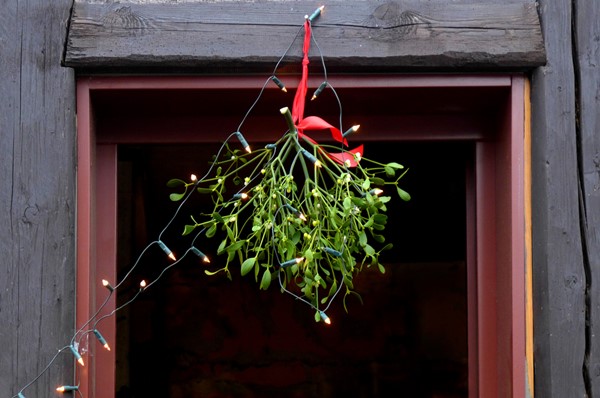
Which winter-holiday celebration would be complete without a kiss under the mistletoe? This mysterious plant that appears above doorways and arches to catch unsuspecting lovers in a clinch adds fun and even drama to festive occasions. Ho-ho the mistletoe indeed!
Tradition … tradition!
The tradition of kissing under mistletoe began in ancient Rome during the festival of Saturnalia. Across Europe, mistletoe evokes magical, mysterious, and sacred folklore associated with fertility, life, peace, and political power. Greeks and Celtic druids celebrated its many mystical uses. In North America, author Washington Irving refers to the kissing custom in his story “Christmas Eve” from the 1820 collection of essays and stories The Sketch Book of Geoffrey Crayon, Gent. Irving shares that each time a couple kissed under a sprig of mistletoe they took one of the white berries. With every berry gone, the sprig no longer had kissing power.
In Europe, Viscum album, and in North America, Phoradendron serotinum, both with green foliage and small white flowers that become white berries, typically make the holiday décor and begin to appear in stores in late November. Those that don’t may have orange or yellow leaves (dwarf mistletoe) or might resemble a jumble of twigs (called dung twig or witch’s broom) making for a less appreciated spectacle indoors.
- With more than 1,300 species to choose from, only two mistletoe varieties make it into the celebration.
- The parasitic plant attaches to the branches of a variety of trees, pulling nutrients from the tree to itself.
- Clumps of evergreen begin to show when the leaves of deciduous trees fall in late autumn.
- Because the unisex plants are parasites, arborists consider them pests.
- Once mistletoe infects a host, it becomes difficult to remove and eventually disfigures or even kills the host tree.
- More than 20 species make the worldwide endangered plant list.
- Mammals, such as deer and elk, squirrels, chipmunks, and even porcupines eat the mistletoe’s berries.
- Many bluebirds, robins, chickadees, and other bird species, such as mourning doves, also eat the white berries.
- Each white berry produces a single seed. As birds and other animals eat the berries and leave the seeds behind in droppings, new mistletoe grows and attaches to trees and plants.
- Toxic to humans, both the leaves and berries of mistletoe may cause drowsiness, diarrhea, vomiting and nausea, blurred vision, weakness, and even seizures. Nevertheless, medicinal use of mistletoe goes back centuries for treating hypertension, arthritis, infertility, headaches, seizures and even some cancers, including colon cancer.
- Three species of US butterflies rely on mistletoe to survive by laying eggs on the mistletoe so that young pupae can fee on the mistletoe nectar.
- Certain bee species also rely on mistletoe for survival.
For information on harvesting or removing mistletoe from trees, contact a certified arborist.
About the Author

Lucas and Associates REALTORS Inc.
Whether you're in the research phase at the beginning of your real estate search or you know exactly what you're looking for, you'll benefit from having a real estate professional by your side. We would be honored to put my real estate experience to work for you.
